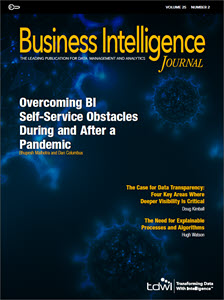
Business Intelligence Journal | Vol 25, No 2
TDWI Member Exclusive
December 18, 2020
What’s the secret to getting the most from your enterprise data? From data models to AI algorithms, data lineage to data governance, users have to feel confident that the data is collected, created, and cleaned properly.
Senior editor Hugh Watson focuses on how explainable AI (XAI) and predictive models build trust in data. In addition to exploring technology options, Watson looks at four steps enterprises must take to ensure that analytics applications meet the demands of management, laws, and regulators as well as calls from the public for greater explainability.
Another technique is explored by our experts John O’Brien, James Taylor, and Coy Yonce: ModelOps—automating model building and implementing and updating processes. They offer suggestions for scaling analytics in terms of people, data, models, technologies, and processes.
Doug Kimball explores data transparency, offering four key areas where enterprises must provide deeper visibility, driven in part by a host of new regulations. He offers tips for leveraging data management technology for the transparency businesses and their customers demand.
Once you trust your data, how can you use it to make truly data-driven decisions? Gaurav Anand looks at how the lack of a framework for viewing data and generating insights impedes decision making. He proposes a business management system to help enterprises overcome the challenges.
Putting analytics in the hands of business users is at the heart of the self-service BI movement, and in our cover story, Bhupesh Malhotra and Dan Columbus describe how your enterprise can overcome BI self-service obstacles during and after a pandemic.
AI and ML can also help users develop insights faster. Arup Duttaroy details the machine learning tasks enterprises can automate to realize error-proof productivity gains and promote democratization of data science.
Of course, data never stands still, and neither do data sources. Eric J. Peters explains how a DW/BI development team can architect new source systems into a data warehouse so users can produce the reports and make the decisions they need quickly. He offers a framework to keep end users nimble while maintaining the integrity and durability of the enterprise data warehouse.
We welcome your thoughts about this issue; write me at [email protected].